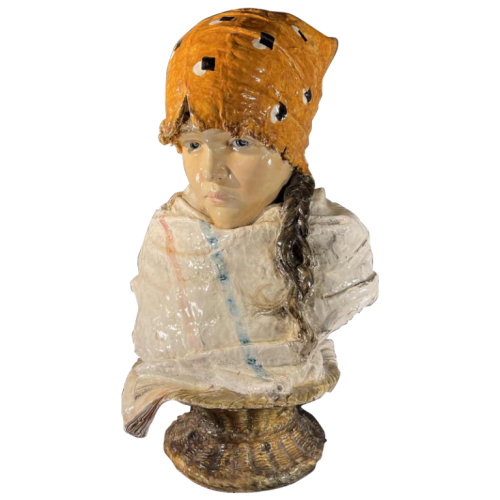- Creator / Artist / Designer:Michele Sansebastiano e Cesare Moreno (1852-1908)
- Signature / Monogram:Signed "SM"
- Period:19th Century / 1890
- Country of Origin:Italy
- Dimensions (H x W x D):52 x 31 x 33 cm
- Weight:6 Kg
- Condition:Good
- Style:Art Nouveau / Impressionist
- Material:Ceramic
-
Price:SOLD
- Belgium Delivery:Free
- International Delivery:On request
Manufacture Michele Sansebastiano & Moreno Cesare (Genova).
Bust of a young girl / woman, polychrome ceramic, ca 1890
Rare and large sculpture in Impressionist style and period, announcing the beginnings of Art Nouveau.
Very good original condition, some small enamel gaps but nothing serious (see photos).
Signed hollow under the terrace "SM", a brand known to artists (see photo)
Biography:
Sansebatiano e Moreno, historically founded in San Martino d'Albaro (Genoa) in 1883 by sculptor Michele Sansebastiano (1853-1906) and entrepreneur Cesare Moreno. Her creations (notably sculptures of women or groups of women in polychrome terracotta under varnish and enamelled ceramics in polychromy) are very successful in important exhibitions, such as the Universal Exhibition of Turin (1884), of Barcelona (1888). ) and in particular the Universal Exhibition of Antwerp (1885) which made the company known in Belgium. In 1899, Antonino Quinzio and Saverio Canepa took over and founded Quinzio and Canepa in Sanpierdarena.
The factory ceased production for good in 1905, selling the molds to ceramicist Nicolò Poggi, one of the first potters to offer the Liberty style at the time.
Michele Sansebastiano (Novi Ligure, 1852 - Genoa, 1908) trained at the Academy of Fine Arts Ligustica in Genoa. He opened a workshop of some renown, preferring terracotta, stucco and marble as materials. He exhibited at the Society for the Promotion of Fine Arts (from 1871 to 1892) and was appointed academician of the Academy of Fine Arts of Ligustica. In 1883, he founded with Cesare Moreno the Sansebastiano e Moreno, a factory for the production of artistic ceramics. He sculpted the colossal Telamons or Atlantes of the Genoese Palazzo dei Giganti.
